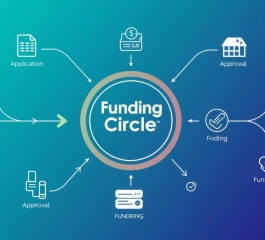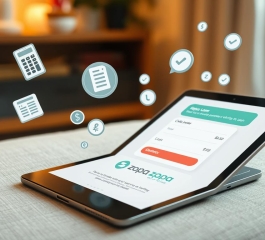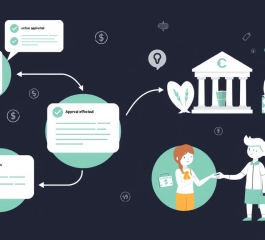Step by step to apply for a quick and easy loan
Need financial help? It can be stressful, but it doesn’t have to be. This guide makes getting a loan easy and fast. We’ll show you how to find the right loan in the UK and how to apply smoothly.
Applying for a loan doesn’t have to be hard. Our guide helps you through the process easily. It’s perfect for covering unexpected costs or funding a project. We’ll give you all the key information you need.
Key Takeaways
- Understand the straightforward quick loan process for stress-free borrowing.
- Gather insights on how to effectively apply for a loan without confusion.
- Benefit from a comprehensive loan application guide for efficient financial planning.
- Learn about the various types of loans to find the perfect fit for your financial needs.
- Gain an understanding of the documentation and eligibility requirements ahead of time.
Understanding the Basics of a Quick Loan
When looking at financing options, it’s key to know what a quick loan is. These loans are known for their fast application and quick cash. They can help with personal, home, or business needs. It’s important to understand the details of each loan and their interest rates to make a good choice.
What is a Quick Loan?
A quick loan is made for speed and ease. It’s a fast way to get money without waiting long like with bank loans. They’re perfect for urgent money needs where time is critical.
Differences Between Personal, Home, and Business Loans
Each loan has its own purpose:
- Personal loans are flexible and unsecured. They can be used for many things, from paying off debt to covering unexpected bills.
- Home loans, or mortgages, are for buying property. They have longer terms and lower rates because you’re using your home as collateral.
- Business loans give businesses the money they need. This can be for starting up or growing, based on the business’s financial health and future plans.
Loan Interest Rates Explained
Loan interest rates are very important when borrowing money. They show the total cost of the loan over time. Rates are influenced by the loan type, risk, your credit score, and the economy.
Table: Comparative Overview of Loan Types and Interest Rates
Type of Loan Typical Interest Rate Repayment Period Personal Loan 4% – 36% 1-7 years Home Loan 2% – 5% 15-30 years Business Loan 3% – 18% 1-15 years
Assessing Your Loan Eligibility
Knowing what lenders look for when approving loans is key. To check if you’re eligible, you need to look at your creditworthiness. This includes several important factors that lenders consider.
Your credit score is very important. A good score means you’re seen as a reliable borrower. This can help you get approved for loans and even get better interest rates.
Your income and job stability also matter a lot. Lenders want to see that you can pay back the loan. So, having a steady job is crucial for getting a loan.
- Credit Score: A higher score can significantly increase your eligibility.
- Income Stability: Consistent and adequate income levels are preferable.
- Employment: Long-term, stable employment is favoured by lenders.
To understand how lenders evaluate these factors, here’s a table. It shows how each element affects your creditworthiness.
Criteria Impact on Loan Eligibility Tips for Improvement Credit Score High impact – essential for determining interest rates and approval chances. Maintain timely bill payments and reduce outstanding debt. Income Level High impact – assures lenders of your repayment capability. Seek stable employment; provide additional income proof if possible. Employment Status Medium impact – continuous employment preferred. Limit job-hopping if seeking loan approval soon.
By focusing on these key areas, you can improve your chances of getting a loan. You’ll also have a better chance of getting good terms.
How to Choose the Right Type of Loan for Your Needs
Choosing the right loan is all about understanding your financial needs. Financial needs analysis helps you make the best choice. Think about the loan amount, repayment terms, and why you need the loan.
Comparing loans is complex but crucial. It’s important to look at the pros and cons of each option. Consider your financial situation and goals.
- The amount of money you need to borrow (align it with your financial capacity)
- The expected repayment period (short-term vs. long-term loans)
- The purpose of the loan (e.g., home renovation, business expansion)
- Interest rates and additional charges
- Loan comparison tools and services
Here’s a table to help you compare loans:
Type of Loan Purpose Typical Loan Term Average Interest Rate Personal Loan Debt Consolidation, Emergency Expenses 1-5 years 3% – 36% Home Loan Home Purchase or Renovation 15-30 years 2.5% – 4.5% Business Loan Business Starting or Expansion 1-15 years 5% – 15%
When choosing a loan, do a deep financial needs analysis. This ensures the loan fits your financial situation. Whether for personal needs, a home, or business, knowing your options helps make better financial choices.
Documentation Required for Loan Applications
When you apply for financial help, knowing what loan documentation you need is key. It speeds up your application and boosts your approval chances. Employed or self-employed, you’ll need specific documents to prove your application requirements and proof of income.
Gathering Essential Documents
Start by gathering all the necessary documents for your loan application. Here’s a list of common items:
- Proof of identity (Passport, driver’s licence)
- Proof of address (Utility bill, council tax bill not older than three months)
- Bank statements for the last three months
- Proof of income (Recent payslips or income statements)
- Credit report
Make sure these documents are up-to-date and show your financial situation accurately. This helps lenders quickly check your details and decide on your loan.
Supporting Evidence for Self-Employed Applicants
If you’re self-employed, showing a steady income is a bit trickier. You’ll need:
- Recent tax returns
- Business bank statements for the last six months
- Proof of business registration and ownership
- Proof of any extra income sources
These documents give lenders a better view of your business and income stability. This is crucial for them to judge if you can repay the loan.
Keeping your documents organised can greatly affect your loan application’s success. Always ask your lender if they need any specific forms or formats to make things easier.
Document Type General Applicants Self-Employed Applicants Proof of Identity Required Required Proof of Address Required Required Bank Statements Last 3 months Last 6 months (Business) Income Verification Payslips/Income Statements Tax Returns/Business Statements Credit Report Required Required
Utilising a Loan Calculator to Estimate Repayments
Using a loan calculator can make planning your loan much easier. It helps you see how much you’ll pay back each month. This way, you can budget better and avoid any surprises.
How to Use a Loan Calculator
To get the most from a loan calculator, enter your details carefully. First, put in how much you want to borrow. Then, add the interest rate and how long you’ll take to pay it back. The calculator will then show you your monthly payments.
Understanding the Inputs and Outputs
The details you put into a loan calculator are very important. You need to know the loan amount, interest rate, and how long you’ll repay it. The calculator will show you your monthly payments, total interest, and the total cost of the loan.
It’s key to understand these numbers when planning your loan. They affect your finances for the loan’s whole term. Here’s what you might see after using a calculator.
Loan Amount Interest Rate Loan Term Monthly Repayment Total Interest Total Repayment £10,000 5% 5 years £188.71 £1,322.60 £11,322.60 £15,000 5% 10 years £159.03 £4,083.60 £19,083.60 £20,000 4.5% 3 years £596.49 £1,473.64 £21,473.64
These tables show the big commitment of taking out a loan. They also stress the importance of a good interest rate and a repayment term that fits your budget.
Filling Out the Loan Application Form
Starting the application process can feel overwhelming. But, with a good plan for filling out the loan application form, it can be smooth. Here’s a detailed guide to help you through this key part of applying for a loan.
First, make sure all your personal and financial info is up to date and correct. Wrong details can slow down your loan approval or even deny it.
- Personal Information: Includes your full name, date of birth, and national insurance number.
- Financial Details: Covers your job, salary, monthly bills, other income, and how much you need to borrow.
- Contact Information: Your address, phone number, and email.
Next, understand each part of the loan application form well. This helps avoid mistakes that could slow down your loan approval:
Section Common Errors Tips to Avoid Errors Personal Information Outdated details, typos Double-check all entries for current information and spelling Financial Information Inaccurate income reporting Use recent pay slips and bank statements for reference Required Loan Amount Unrealistic amount requests Consider your repayment capability objectively
Knowing what happens after you submit your application is key. After you send it, your details will be checked, your credit score looked at, and if you can pay back the loan.
Applying for a loan doesn’t have to be hard. With the right preparation and knowledge of the application process, you can improve your chances of getting approved and go through it confidently.
Conclusion
Getting the funds you need can be easy if you know what to do. This article has shown you how to prepare for your loan application. You’ll learn about different loans, how to prepare your documents, and use loan calculators.
After you apply and get approved, it’s time to think about what’s next. You need to plan your finances and make a budget for loan repayments. You should also think about how to use the loan money wisely, for personal growth, home improvements, or business investments.
It’s important to keep an eye on your finances after getting a loan. Borrowing money responsibly and paying it back on time helps your financial health. This can lead to better loan terms in the future. With the knowledge from this article, you’re ready to handle your loan application and finances. Now, you can move forward into your new financial chapter with confidence.
FAQ
What is a Quick Loan?
A quick loan is fast to get and use. It’s for when you need money quickly. This could be for unexpected bills or new chances.
Can you explain the differences between Personal, Home, and Business Loans?
Personal loans help with personal costs. Home loans are for buying property. Business loans fund your business, secured or unsecured.
How exactly do Loan Interest Rates affect cost over time?
Interest rates add to your loan cost. A high rate means more to pay. A low rate makes borrowing cheaper.
What are the common Loan Eligibility criteria?
You need a good credit score and steady income. Employed status is also checked. Lenders use these to see if you can repay.
How can I choose the Right Type of Loan for my needs?
Think about your finances and why you need the loan. Look at the amount, repayment terms, and rates. Compare to find the best fit for you.
What Essential Documents are required for Loan Applications?
You’ll need ID, income proof, and employment verification. Financial statements are also needed. Requirements vary by lender and loan type.
What Additional Documentation do Self-Employed Applicants need for a Loan?
Self-employed people must show business finances and tax returns. They also need proof of stable income, like client contracts.
How do I Use a Loan Calculator?
Put in the loan amount, rate, and term. The calculator shows monthly payments and total cost. This helps with budgeting.
What is the importance of Understanding the Inputs and Outputs in a Loan Calculator?
Right inputs give accurate estimates. Knowing the outputs helps you plan. It shows monthly payments and total interest, aiding in budgeting.
What are the key tips for Filling Out a Loan Application Form?
Read the form carefully and fill it out right. Have all documents ready. Double-check your answers to avoid mistakes.
What should I expect after submitting a Loan Application?
The lender will check your application and credit. They might ask for more info. You’ll get a yes or no soon. If yes, you’ll sign the agreement and get the money.




